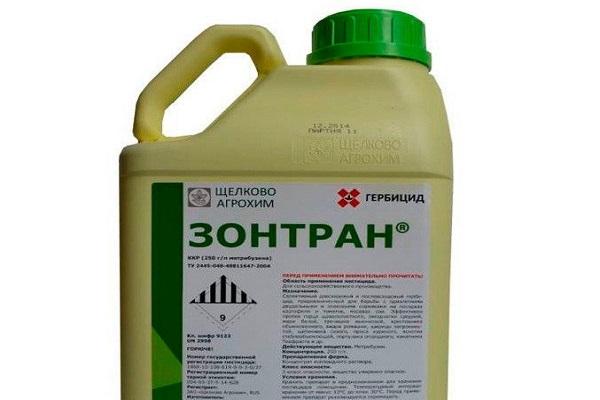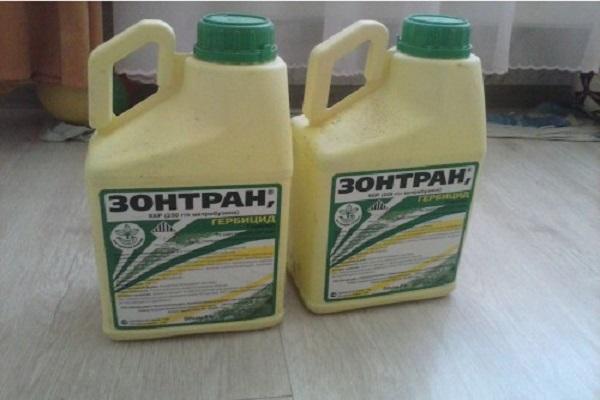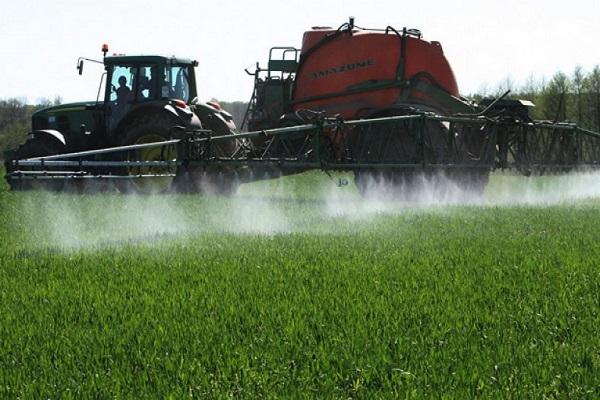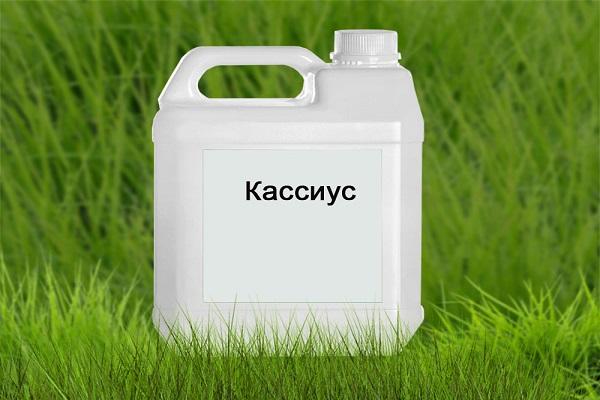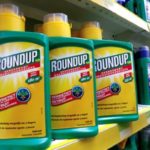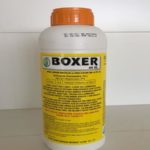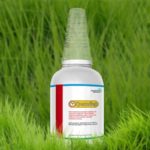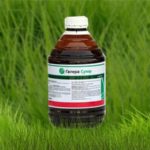Zontran is a herbicide that, according to the instructions for use, can be used against weeds growing on tomato and potato plantings. The herbicidal agent has selective activity and acts only on weeds. The drug penetrates inside the plants and stops the processes of photosynthesis, and then leads to the complete death of the weeds.
- Composition, release form and purpose of the weed remedy Zontran
- Mechanism of action of the drug
- Advantages and disadvantages of herbicide
- Consumption rate for different plants
- Preparation and use of working solution
- Safety precautions
- Degree of herbicide toxicity
- Drug compatibility
- Shelf life and storage conditions
- Analogs
Composition, release form and purpose of the weed remedy Zontran
The herbicide Zontran is used to combat annual dicotyledonous and cereal weeds that interfere with the growth of tomatoes, potatoes, and soybeans. It is used against ragweed, chamomile, sow thistle, shepherd's purse, cornflower, knotweed, woodlice. Does not affect wheatgrass, thistle, bindweed, or perennial grass weeds. The drug contains metribuzin, which belongs to the triazinone class. The systemic herbicide penetrates the weeds and leads to their death.
The chemical has selective activity, that is, it acts only on weeds and does not cause any harm to the main crops. The herbicide is used before and after plant germination.
The maximum dose is taken before the sprouts of tomatoes and potatoes appear. After the main crops emerge, the dosage is reduced.
The drug is in the form of a concentrated colloidal solution. Before use, dilute with water. Used for irrigating fields and killing weeds. Produced by the Russian company Shchelkovo Agrokhim.
Packaging - plastic canister with a volume of 5-10 liters, ampoules of 5 milliliters, plastic bottles of 10,50,100 milliliters. The herbicide can be used in large farms and small private farms.
Mechanism of action of the drug
The herbicide penetrates into the weeds through leaves and roots. The active substance inhibits photosynthesis. The herbicide slowly decomposes in the soil, therefore it has a long-term protective effect, protecting crops from weeds throughout the entire growing season.
Plant growth stops immediately after the active substance is ingested. After 2-5 days, necrosis and chlorosis occurs. Weeds die completely after 2-3 weeks. The herbicide exhibits the highest activity during the initial growth of weeds.
Advantages and disadvantages of herbicide
Advantages of Zontran:
- quickly penetrates the weeds and immediately begins to act;
- has selective activity, provides long-term protection against weeds;
- the working solution is resistant to delamination;
- drug consumption rates are minimal.
Consumption rate for different plants
Herbicide Zontran is used in the following dosages (per 100 square meters):
- For tomato seedlings. Consumption of the drug: 17 milliliters per 5 liters of water. Spraying is carried out 15-20 days after planting the seedlings in the garden bed. During the season, 2 treatments can be carried out with an interval of 60 days.
- For sowing tomatoes. Herbicide consumption rate: 4-15 milliliters per 3 liters of liquid. Treatment is carried out in the phase of 2-4 leaves of the main crop. 2 sprayings are allowed with an interval of 60 days.
- For potatoes. Herbicide consumption: 10-15 milliliters per 3 liters of water. Spraying is carried out before the potatoes emerge and when the tops are more than 5 centimeters high. During the second treatment, the dosage is reduced by half. There are 2 irrigations per season. The interval between treatments is 30 days.
Preparation and use of working solution
The working solution is prepared in a plastic container on the day of spraying. Take the required dose of the drug and dissolve it in a small amount of water. Then add liquid to the required volume. The herbicide dissolved in water is poured into a sprayer or into the tank of a fine dispersion sprayer.
Irrigation is carried out in dry and windless weather. It is not recommended to treat weeds in rain, strong winds or during the active summer of bees. You need to use all the prepared solution in a day, and pour the remainder beyond the borders of agricultural land.
Safety precautions
Zontran is non-toxic to humans, however, when working with this herbicide you must adhere to safety precautions. Do not inhale vapors or drink the herbicide solution. Field work is carried out in a protective suit, a mask or respirator, boots and rubber gloves. After spraying the field, you need to take off your clothes, wash your hands and face with warm water and soap, and rinse your mouth with a soda solution.
Degree of herbicide toxicity
Zontran belongs to toxicity class 3. The drug is harmless to humans and animals, but the herbicide is not allowed to be used near reservoirs where fish are bred, or during the active summer of bees. It decomposes in the soil within 1-3 months. Does not affect soil insects.
Drug compatibility
Zontran is compatible with other pesticides. The chemical can be used with herbicides based on rimsulfuron (Cassius) for complex treatment of weeds in tomato and potato plantings.
When combined with several drugs at once, you need to reduce the dosage of each component. Zontran is used in conjunction with fungicidal and insecticidal agents to protect crops. Before use, all drugs must be checked for compatibility.
Shelf life and storage conditions
The drug should be used in tightly closed original packaging before the expiration date. The herbicide can be stored for no more than 2-3 years. To store a chemical, you need a special warehouse protected from moisture and sunlight. The drug is kept out of the reach of children, away from food. The optimal storage temperature is 10-20 degrees above zero.
Analogs
The chemical Zontran has analogues, that is, herbicides with a similar composition and principle of action.
The following drugs contain the active substance metribuzin: Zenkor Ultra, Contact, Lazurit, Metrifar, Soil, Torero, Tiron, Unimark. In private household plots, in addition to the herbicide Zontran, the preparations Lazurit and Zenkor Ultra are more often used. Pesticides are used in fields of potatoes, tomatoes, soybeans, corn, for processing roses, echinacea, and alfalfa.

